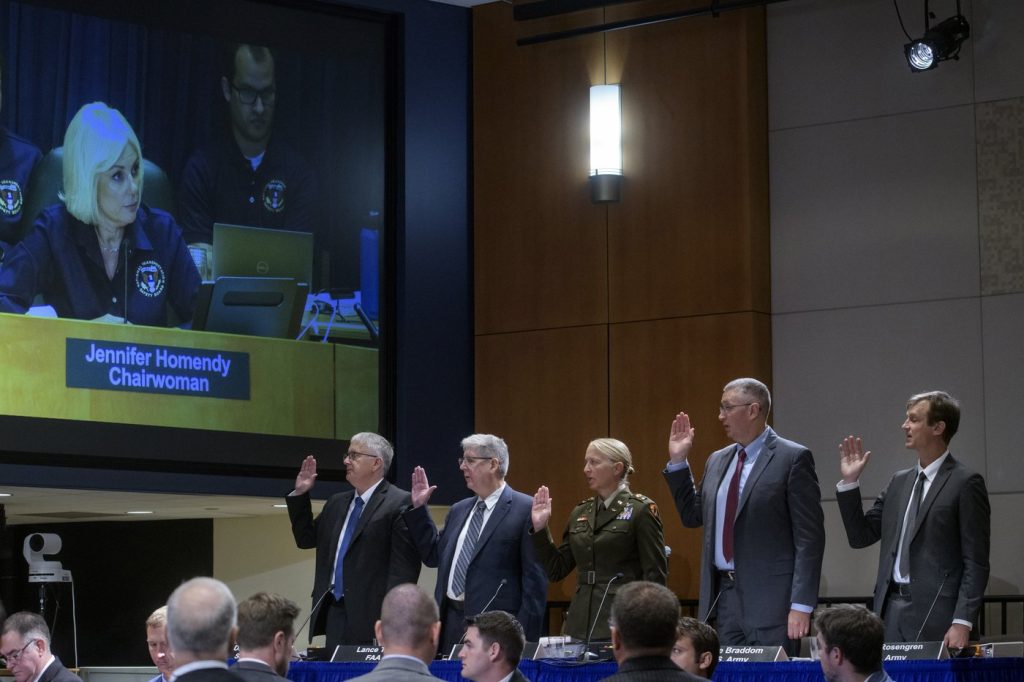The National Transportation Safety Board (NTSB) commenced its third and final day of public testimony on Friday regarding the deadly midair collision that occurred in January between an Army Black Hawk helicopter and a commercial jet. This tragic incident resulted in the loss of all 67 lives aboard both aircraft, marking it as the nation’s deadliest plane crash since November 2001. Board Chairwoman Jennifer Homendy emphasized the urgency for the Federal Aviation Administration (FAA) to improve its oversight, citing long-ignored warnings regarding heavy helicopter traffic near Ronald Reagan National Airport.
Preliminary testimonies highlighted several contributing factors that likely played a role in the crash. Notably, the Black Hawk helicopter was reported to be operating above the prescribed altitude limits for the route it was navigating, raising concerns about safety protocols. Despite ongoing investigations, it remains too early for the board to definitively identify the exact cause of the collision; a comprehensive report is expected to be released next year.
In the hearings, air traffic control practices came under scrutiny. Pilots frequently relied on visual separation—using their eyesight to navigate around other aircraft—which was the approach taken by the Black Hawk pilots, who were wearing night vision goggles at the time. FAA officials noted that this reliance on pilot visual assessments was commonplace due to the complex airspace congestion in Washington, D.C. However, Rick Dressler, an official with Metro Aviation, raised concerns about the difficulty of detecting other aircraft in the nighttime sky, particularly when key onboard locator systems had been turned off, which was a common practice among Army helicopters.
Dressler expressed discomfort among civilian helicopter pilots regarding the operations of military helicopters in the area, noting the potential risks due to the relative inexperience of military pilots unfamiliar with the intricate traffic patterns of D.C. airspace. He criticized the lack of communication and collaboration, stating that Army pilots often do not attend regular meetings with other aviators to discuss airspace issues, further complicating the dynamics of helicopter traffic management.
The American Airlines jet involved in the incident was arriving from Wichita, Kansas, and carried passengers including elite young figure skaters, their parents, coaches, and union steamfitters from the Washington area. Details revealed during the testimony also focused on the final communications from the Black Hawk crew, who had been in contact with the airport’s control tower. Unfortunately, crucial instructions given by air traffic controllers were not heard due to technical issues, leading to tragic consequences just moments before the crash.
John Cox, an aviation safety expert, underscored the hearings' significance in unraveling the complex circumstances of the collision, questioning the factors that led to the Black Hawk operating above the prescribed elevation limit. Additionally, he emphasized the importance of maintaining adequate separation between helicopters and landing aircraft to prevent similar incidents in the future. Investigators reported that the flight data recorder indicated the Black Hawk was flying 80 to 100 feet higher than what the pilots' altimeter suggested, presenting further complications for pilot navigation.
As the investigation continues, the testimonies underscore the critical need for improved safety measures and communication protocols within the congested airspace around Washington, D.C., especially concerning military aviation operations. The insights gathered could pave the way for significant operational changes to enhance air safety and prevent future tragedies.










